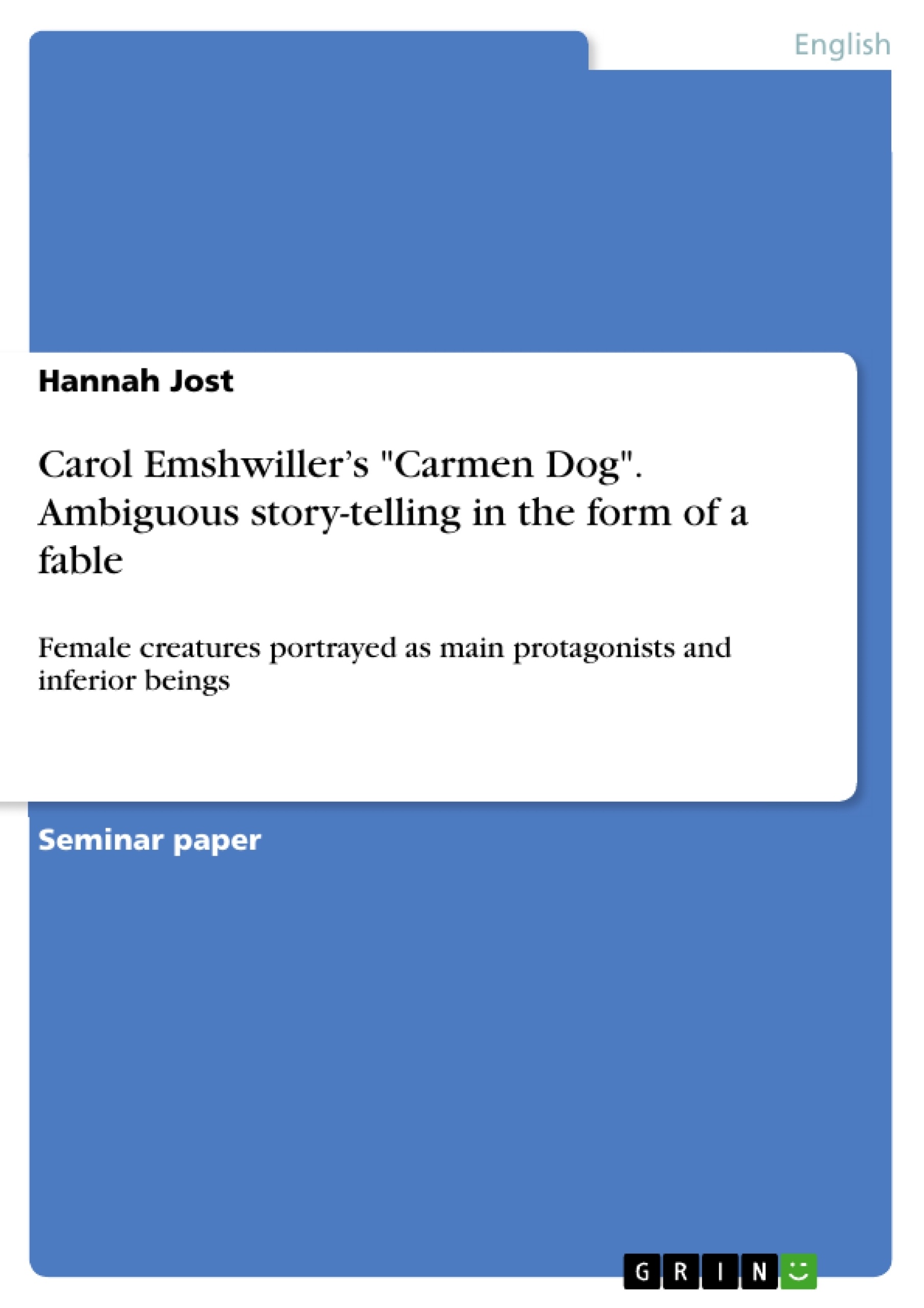Examples of feminist literature are Betty Friedan’s The Feminine Mystique, a critical analysis of the American society, and Virginia Woolf’s work A Room of One’s Own, in which she focusses on the limited or rather not even existing rights of female authors. (Cf. Temple) While the first book is an analysis and the second one is an extended essay, Carol Emshwiller, an American author, comes up with another, different way of expressing feminist thoughts in written form in 1990 – a fable. How this kind of literary genre contributes to the display of the subject of feminism and how it is used in the purpose of Emshwiller’s ambiguous story-telling in Carmen Dog will be described and interpreted in this paper.
“First-wave feminism is that version of feminism that emphasises women’s social and political rights.” (Higgs 2006) It “demanded that women have certain rights: to vote, to equal pay, to equality before law, and to divorce. […] Second-wave feminism examines the highly questionable assumption underlying male domination. […] Moreover, second-wave feminists have uncovered much credible historical evidence which suggests that women’s achievements in arts, maths and science have been systematically suppressed by men.” (Higgs 2006)
The third wave of feminism “emerged in the 1990s” and “defines itself as a budding political movement with strong affiliations to second wave feminist theory and activism. Third wave feminism speaks to a generation of younger feminists – born in the 19060s and 1970s – who see their work founded on second wave principles [inequalities concerning sexuality, family and the work place], yet distinguished by a number of political and cultural differences.” (Barbon 2009)
Inhaltsverzeichnis (Table of Contents)
- Feminism and Its Influence on Literature...
- The Purpose and Features of a Fable......
- Definition of a Fable.
- The Use of an Animal as the Protagonist in Carmen Dog...
- Female Creatures Portrayed as Main Protagonists and Inferior Beings......
- Female Creatures Portrayed as Main Protagonists......
- Women Turning into Animals……
- Animals Turning into Women....
- Female Creatures Portrayed as Inferior Beings.......
- Gender-based Role Allocation/Division of Work..
- Acceptance of the Transformation......
- The Scientific Perspective.......
- Sexual Harassment and Abuse...
- Female Creatures Portrayed as Main Protagonists......
- Actual Incidents of Misogyny as presented in Carmen Dog...
Zielsetzung und Themenschwerpunkte (Objectives and Key Themes)
This paper aims to analyze Carol Emshwiller's Carmen Dog as a feminist fable, examining how the narrative utilizes the genre's conventions to explore themes of gender, power, and transformation. The paper will focus on the portrayal of female characters as both protagonists and inferior beings, considering the use of animalistic imagery and its implications for the representation of women.
- Feminist themes in literature
- The characteristics of a fable and its use in Carmen Dog
- The portrayal of female creatures as both main protagonists and inferior beings
- The transformation of women into animals and vice versa in the context of gender roles
- Misogyny as presented in Carmen Dog
Zusammenfassung der Kapitel (Chapter Summaries)
The first chapter delves into the concept of feminism, tracing its development through different waves and exploring its influence on literature. It examines key feminist texts such as Betty Friedan's The Feminine Mystique and Virginia Woolf's A Room of One's Own, highlighting their significance in the feminist discourse.
Chapter two introduces the concept of a fable, defining its key features and analyzing how Carmen Dog aligns with this genre. The chapter explores the use of animals as protagonists in fables and examines how Emshwiller utilizes the trope of animal-human transformation to explore themes of gender and power.
Chapter three focuses on the representation of female characters in Carmen Dog. It analyzes how female creatures are portrayed as both protagonists and inferior beings, exploring the different ways in which Emshwiller uses animalistic imagery to comment on gender roles and societal expectations.
The fourth chapter examines instances of misogyny presented in Carmen Dog, highlighting specific incidents that underscore the novel's feminist critique of male dominance and the exploitation of women.
Schlüsselwörter (Keywords)
This paper explores the intersection of feminism and fable, focusing on the themes of gender, transformation, and misogyny as presented in Carmen Dog. Key concepts include the portrayal of women as protagonists and inferior beings, the use of animalistic imagery, and the exploration of power dynamics between men and women.
- Quote paper
- Hannah Jost (Author), 2015, Carol Emshwiller’s "Carmen Dog". Ambiguous story-telling in the form of a fable, Munich, GRIN Verlag, https://www.grin.com/document/373570



